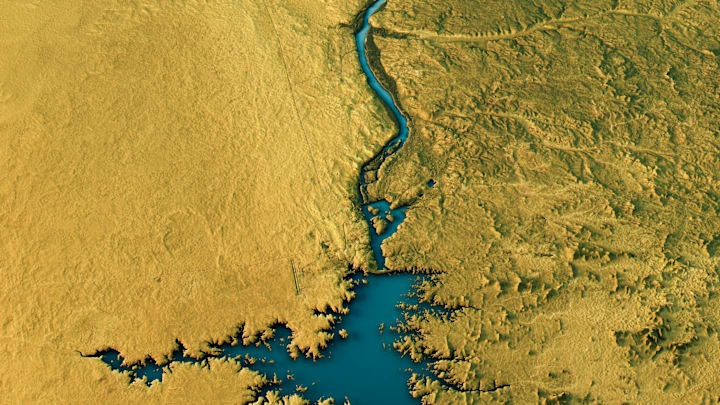The answer to the question “What’s the longest river in the world?” might sound simple—find the source, the mouth, and measure—but in between those steps are strange definitions, fractals, hydrology, and especially national pride. It’s an issue so complicated that several hydrologists contacted by Mental Floss explained that river length isn't even considered a useful measure anymore. So, what is the longest river in the world?
How long is a river?
According to Laurel Larsen, an associate professor within the University of California Berkeley’s geography department, “The length of a particular river is the longest possible along-thalweg continuous distance from the headwaters (first order stream) to the mouth of a river.”
To unpack those terms, the thalweg is “the line connecting the lowest or deepest points along a stream bed or valley.” First order stream is more complicated. There are two major ways to classify stream order, but the most common is the Strahler method. In this method, streams without any tributaries entering it—streams that are just starting out the river—are first order. When two first order streams join together, they form a second order stream, and when two second order streams join they form a third order (but if a first order stream intersects with a second order, the main river stays a second order stream).
The source of a river then is considered to be the furthest distance to the source of a stream that has no inputs—although, in practice, this can be extremely difficult to determine. And it's not a perfect system. (For historical reasons, the source of the Mississippi is often treated separately from the Missouri, despite the conventional definition grouping them into one river system.)
As for the mouth? That’s also contentious. For some rivers, the mouth is relatively simple to determine. But for large rivers entering the ocean, like the Amazon, where the mouth is placed can make all the difference.
Are we going to answer the question?
Typically, the Nile has always been considered the longest river, with the Amazon coming in second. But in 2007, a team of Brazilian scientists announced that a new analysis put the Amazon on top. They got this by identifying a new source and, more importantly, a new mouth. Traditionally, the mouth of the Amazon has been located on the north side of Marajó Island. But this new report wrapped the river around the south side of the island to the Pará River and then out into the ocean.
What side of an island the mouth is on might not seem all that relevant, but Marajó Island is the size of Switzerland. The new source plus the new mouth gave a distance longer than the Nile.
This was controversial. The Pará River is usually associated with the Tocantins River, not the Amazon. And more recent studies have tended to agree that, although there is some Amazon water in it, the Pará is distinct from the Amazon. Which means that the current best guess for the longest river in the world is still the Nile.
But there’s another, more fundamental issue with measuring a river: What does length even mean?
So what's the problem?
The early 20th century mathematician Lewis Fry Richardson made the observation that Spain and Portugal disagreed on their border length. Spain said it was 987 km and Portugal maintained it was 1214 km. The disagreement wasn’t down to disputed territories or anything like that; Richardson explained that it was the length of the measuring stick. As the measuring stick gets smaller, it’s able to more accurately capture the curves and nuances of bends and curves in complex borders.
The same trick appears with rivers. Rivers meander and have small curves. And if you zoom in further, more little bends and twists might appear in the thalweg.
It’s known as the coastline paradox: The length of something complex is basically impossible to determine because the length keeps increasing the smaller the measurement goes.
For both this reason and the inherent difficulties of determining length, several researchers have told Mental Floss that river length just isn’t something that particularly matters, and what is really important is drainage area, which is the area of land that contributes water to the river. Unlike river length, a few elevation measurements make this a much easier metric to calculate. And according to an article in Nature, using this metric, the Amazon is dramatically the largest river in the world, with a drainage area of 6.3 million square kilometers. If it were a country, the drainage basin would be the seventh largest country in the world—just behind Australia.
Have you got a Big Question you'd like us to answer? If so, let us know by emailing us at bigquestions@mentalfloss.com.
A version of this story ran in 2017; it has been updated for 2022.
